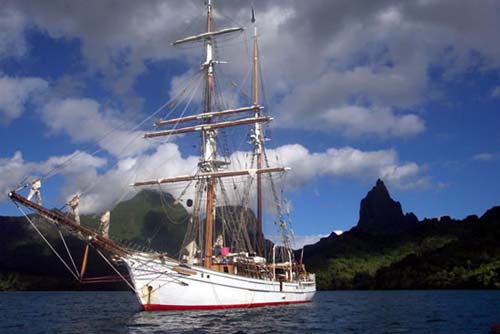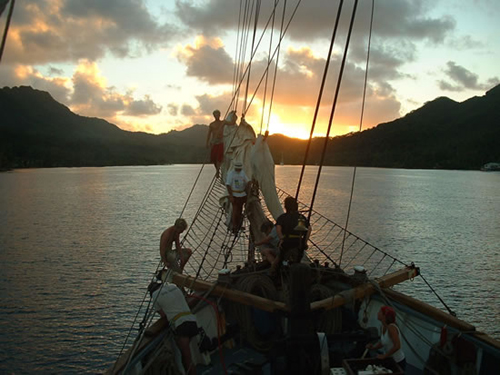
Note from Chuck Meide, LAMP Director: Karson Winslow, a graduate student from Flinders University in Australia, was one of our two first LAMP interns under the First Coast Maritime Archaeology Project. She worked with us from July to October 2007. When she left us, it was one of the few times that our entire LAMP staff was jealous of our intern’s next job, which was cruising the South Seas as a crew member on board an authentic tall sailing ship. At that time we invited her to guest blog her experiences, and now that she is back home in the U.S.A. she has taken us up on her offer. Prepare to enjoy her account of blue seas, green isles, white canvas, and wooden decks . . .
I spent a year doing something that people only dream about, if they know it even exists. When I discovered a way to see the South Pacific through the eyes of an early explorer, I knew there was no way to let an opportunity like this sail away.
After saying farewell to the Lighthouse team in St. Augustine, I joined the Tall Ship Soren Larsen in Auckland, New Zealand with only a small notion of what would lay ahead.
The brigantine Soren Larsen underway.
The vessel is a 1949 Brigantine rigged wooden tall ship, built in Denmark as a Baltic Trader. After a short life in the cold sea, the vessel was no longer needed and spent a decade dormant. In 1978 a gentleman by the name of Tony Davies, with love in his heart bought the ship and started the transformation of what it is today.
Soren out of the water for a two month refit.
The ship today is under new ownership, though I had the honor of meeting Tony, a man that knows everything there is to know about Soren, from all the parts of its original engine still in use, to the challenges of coming alongside a wharf in the worst of conditions. The most exciting thing to have witnessed was Tony bringing the ship into the dock in Auckland, sitting atop the gallows steering with his feet.
It has been seen around the world in an English TV series, Onedine Line, and as a ship in the ice-packed “Arctic Circle” (Greenland) in Schakleton’s tale. Soren arrived in New Zealand after rounding the horn in 1978 as the Flagship of the reenactment fleet sailing to Australia for the celebration of the Bicentenary. Its new job was to sail the warm waters of the South Pacific as a sail training and adventure tourism vessel, carrying with it a long history dating to its early days in the Baltic Sea.
Under the forward sol board, you can see the large keelson and associated hull timbers.
Jumping ahead in the story, each stop and port reached by Soren gave a chance to revive and relive the maritime history of the region. To follow, I will describe a few of the favorite spots and finds along this vast and rich Maritime Heritage Trail. What was revealed was a mixture of treacherous tales such as the more well known Mutiny on the Bounty with its descendants on both Pitcairn and Norfolk Islands, to the less extreme history and transformation of indigenous watercraft among the different island regions.
Due to weather and a force 11 storm, Soren had to change course and head directly north before reaching Easter Island. This was hard news to take at the time, as we were out at sea for almost 40 days, though we trusted the Captain’s judgment to seek out safe waters. We reached the Society Islands–home to the more popular Tahiti, Bora Bora, Huahine and Moorea–ready to get land legs back and explore.
On one of Captain Cook’s voyages in 1773, he came to the Society Islands and was happily received by the islanders. They came out to the visiting ships in canoes offering fruit, beads, shells, fish and flowers for the visitors. Unaware the ships were encroaching on a reef, Cook’s Resolution struck before they were able to fend off. The sister ship, Adventure, struck as well; both ships deployed anchors, though this did not save them from damage. The men tried to retrieve the anchors the next day, but only were able to grab Resolution’s bower anchor, leaving three more behind.
Captain Cook’s anchor on display at the Tahitian Museum.
In 1978, over two centuries later, only one anchor has been found and excavated. It took one month to remove the anchor from the coral. The other two have not yet been located, letting us only imagine they are still within the reef today.
Another common sight amongst the Pacific Islands are the Marae sites. Made out of stone, these pre –Christian sacred places served as the location of rituals and spiritual practices. Most consist of small stones and a sign indicating what used to be, but there are some still intact. In Ra iatae (Society Island) the remains of Taputapuātea were restored in 1994, giving the Marae the feeling that it could still be in use today. Within the Marquesas Island of Hiva Oa, there is a tucked away Marae rarely visited as the island does not see more than 100 small yachts a year in the village of Puamau.
Marae site on the Marquesas Island of Hiva Oa.
An observation made frequently by myself and others was the presences of Christian churches on even the smallest of islands. Small rooms with alters and pews, with shell chandeliers. When the early explorers came to their islands, so did their religious beliefs.
In the Cook Islands, we had the chance to visit a small atoll called Palmerston Island. This island though small has a very interesting past. When Cook first landed on the island in 1777, there were no current inhabitants on the island and only graves present. In 1863, William Marsters, a ships’ carpenter arrived on the island with two Tahitian wives. He acquired a third wife and had over 17 children with the women. Today there are about 60 inhabitants of Palmerston, all ancestors of William Marsters.
William Marsters grave site on Palmerston Island.
The island itself divided into the three different families from the different wives, and strife exists amongst the small group. Decades ago conflicts arose over the land division of the coconut groves. There are certain areas respective family members to not go in accordance with entitlement boundaries.
Supplies were limited on the island, so when a ship from San Francisco wrecked on the reef (there is no break in the reef for an entrance into the lagoon) the remains were salvaged to build the house for Marsters that still stands today.
Supply house built of Pacific Northwest Timber salvaged from a shipwreck.
On occasion, Soren would take a hard wave, causing for some subsequent work to take place on the ship. With a chippy on board from Shetland, we were back to water-tight in no time. The guys are caulking the deck with oakum and pitch to secure the timbers. Though this was not an everyday occurrence, ship maintenance was never ending and there was always a list of work to be done.
Caulking the deck to ensure water tight for long ocean passages, using a hammer and wedge-like tool called a caulking iron to apply rolled oakum (rope fragments) and pitch into plank seams.
The tale of the Bounty cannot be missed when traveling through the South Pacific. It is present in the form of books and movies, and everything else from postcards to souvenir beer koozies. But the most interesting example of the continuation of the history is the descendants of the mutineers. Upon looking in the phone book in Norfolk Island, there were only about 25 different last names and nicknames needed to differentiate those with the exact same names. The descendants of the mutineers were very proud of their history and could not see life any other way. There were the Christians, the Smiths, the Youngs and the Adams, and a small mixture of surnames in between. The mutineers first sought refuge on Pitcairn Island, where the men took Tahitian wives and raised their families. There was much dispute and once the island population reached a significant size, part of the population moved to Norfolk Island, in between New Caledonia and New Zealand.
The amount of history observed on this journey is too numerous to mention in just one short article. Not only did I get to see over thirty islands, I also had the chance to witness over three centuries of history, and its effect on the cultures of the Pacific even today.

The first and final photographs in this blog entry are courtesy of Tall Ship Soren Larsen. All other photographs taken by Karson Winslow.

